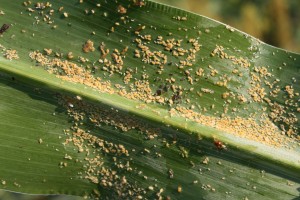We have much fewer acres of grain sorghum planted in Tennessee this year, and I’ve spent a lot less time blogging or answering questions about sugarcane aphid. That has not stopped this pest from being present in most sorghum fields. Please refer to my many previous articles about managing this pest during the last two years … just search for sugarcane aphid in the search bar. There are a couple of things you need to be aware of before making an insecticide application (see below).
-

SCA on the underside of a sorghum leaf In grain sorghum or sorghum grown for silage, only two insecticides are currently labeled and recommended for sugarcane aphid. Transform WG and Sivanto prime (= Sivanto) are the only insecticides that will provide effective control. Transform is available under a Section 18 exemption and can only be applied up to 3 days before blooming begins and after blooming is complete. Sivanto prime can be used all season up to 21 days prior to harvest.
- Tennessee recently received a Crisis Exemption for Sivanto prime in sweet sorghum. This will be a huge help for those producing sorghum molasses who have been devastated by this new pest. The ‘crisis label’ for sweet sorghum is similar to that for grain sorghum, and I would recommend a similar use rate of 4-5 oz/acre. We have to assume the threshold suggested in grain sorghum will apply to sweet sorghum, but I think that is a pretty safe assumption. Current recommendations are to treat when aphid colonies are present on 30 percent or more of plants and occasional leaves have 100 or more aphids present. Treatment should also be considered if honeydew is present in multiple spots throughout a field and aphid populations are increasing.

